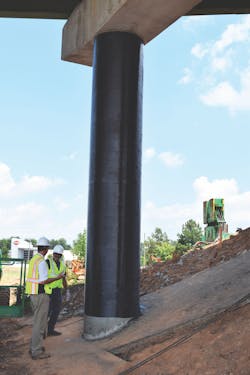SCDOT turns to FRPs to repair failing bridge column
In June of 2016, the South Carolina Department of Transportation (SCDOT) was in the midst of building a new interchange at the intersection of I-85/I-385 in Greenville, S.C. During construction, severe localized spalling was found on the cover concrete of one column of a two-column pier supporting the I-385 northbound ramp. Upon discovery, SCDOT and their consultant closed the ramp to all traffic until a detailed inspection could be made.
After inspecting the affected column, it was determined that immediate repairs were required before allowing truck traffic on the ramp. SCDOT and their consultants designed a traditional concrete jacketing repair where the 30-in. diameter column was enlarged to a square section with reinforced concrete. The emergency repairs were designed, approved, and constructed in a little over a week.
Post-repair inspection of all the columns and pier caps of the old interchange revealed various degrees of corrosion of the reinforcing steel, with the most severe occurring at construction joints. Cracks and small, localized delamination of sections of cover concrete were observed on some of the columns throughout the old interchange, including the column adjacent to the jacket-repaired column.
While these deficiencies were not severe enough to warrant strengthening of the columns, they were treated as potential hazards to both the traveling public and the construction teams working around the structures. SCDOT and joint-venture design-build contractor Flatiron-Zachry sought an economical, high-strength alternative solution to confine the damaged sections of the columns until they were demolished during the eventual reconstruction of the interchange.
Milliken Infrastructure approached SCDOT and Flatiron-Zachry to learn more about the problem and to determine if their RenewWrap Fiber-Reinforced Polymer (FRP) strengthening system could provide a quick repair for the deficient columns.
The RenewWrap system consists of high strength carbon fiber fabrics that are coated in the field with epoxy resins and bonded to or, in the case of the column repairs, wrapped around the structure to strengthen the member being repaired. The thousands of carbon fiber filaments in the FRP fabric perform the same function as reinforcing steel bars, but with the added advantage of being non-corrosive, which allows for placement directly on the surface of the columns.
FRP systems such as RenewWrap have been used in thousands of projects for over 30 years as a cost-efficient means of increasing load capacity, correcting design or construction errors, restoring strength, or meeting more stringent building codes.
Because of its light weight and ease of installation, FRP systems typically require less equipment and result in a lower installed cost of repair to alternatives, making it an ideal solution to prevent further spalling and increase structural strength for the remaining lives of the columns.
Flatiron-Zachry turned to Greer, S.C.-based Osborn Contract Services (OCS), a trained RenewWrap installation contractor, to execute the repairs.
Thanks to the minimal equipment requirements, the existing access area beneath the ramp was more than ample to perform the FRP installation. The crew cleaned the columns and patched small spalls to provide a uniform surface prior to installing the FRP.
The carbon fabric sheets were measured, cut and stored on site until needed. The crew mixed a two-part resin and applied it to the columns using paint rollers, and then wrapped the dry carbon fiber-based fabric around the columns with the fibers aligned horizontally to provide hoop strength. A second coat of epoxy was applied to the fabric for additional strengthening, which was then followed by a second layer of the FRP material in order to meet the confinement design objectives.
OCS used multiple boom lifts to give them access to the entire column surface simultaneously, speeding repair time. The first column wrap was completed in about 8 hours over a two-day period, and subsequent columns were strengthened even faster.
Though this was SCDOT’s first project using the RenewWrap system, the team has great confidence in the solution. Though the FRP solution is technically only a temporary repair until the new interchange is built, the experience has been a positive one for all involved and has given SCDOT an additional tool for strengthening old and deteriorated bridge structures.
